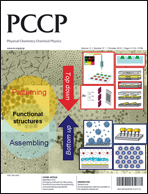Concerted proton–electron transfers in the oxidation of phenols
Abstract
The oxidation of phenols is an emblematic example where the mechanisms of proton-coupled electron transfers could be investigated in depth thanks to non-destructive electrochemical techniques such as cyclic voltammetry. A concerted proton–electron transfer could then be shown to be the prevailing pathway in the oxidation of amino-phenols mimicking the tyrosine–histidine couple in Photosystem II. The theoretical model developed on this occasion leads to the introduction of two main parameters characterizing reorganization of heavy atoms in the reactant and in the solvent on the one hand and proton tunneling on the other. When water used as the solvent is at the same time the proton acceptor, the concerted pathway also predominates. It is characterized by a remarkably large standard rate constant both in electrochemistry and in the oxidation by homogenous reactants. Another aspect of the importance of H-bonding in concerted proton–electron transfer is provided by H-bond relays that efficiently mediate the electron transfer-triggered transport of protons between two sites over large distances thanks to the displacement of two protons concerted with electron transfer. Intermediary protonation of the relay is avoided by fine tuning of its H-bond acceptor and donor properties.


 Please wait while we load your content...
Please wait while we load your content...